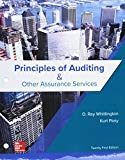
GEN COMBO LL PRINCIPLES OF AUDITING & OTHER ASSURANCE SERVICES; CONNECT AC
21st Edition
ISBN: 9781260427202
Author: Ray Whittington, Kurt Pany
Publisher: McGraw-Hill Education
expand_more
expand_more
format_list_bulleted
Question
Chapter 5, Problem 48BOQ
To determine
Identify the appropriate answer related to the analytical procedures performed at the end of the
Expert Solution & Answer
Want to see the full answer?
Check out a sample textbook solution
Students have asked these similar questions
What is the desired profit for the year?
Please provide the answer to this financial accounting question using the right approach.
What was the balance in interest payable on the 2021 Balance sheet?
Chapter 5 Solutions
GEN COMBO LL PRINCIPLES OF AUDITING & OTHER ASSURANCE SERVICES; CONNECT AC
Ch. 5 - Prob. 1RQCh. 5 - Prob. 2RQCh. 5 - Prob. 3RQCh. 5 - Distinguish among routine, nonroutine, and...Ch. 5 - Prob. 5RQCh. 5 - Prob. 6RQCh. 5 - Prob. 7RQCh. 5 - As part of the verification of accounts receivable...Ch. 5 - Prob. 9RQCh. 5 - When in the course of an audit might the auditors...
Ch. 5 - Prob. 11RQCh. 5 - Prob. 12RQCh. 5 - Prob. 13RQCh. 5 - Prob. 14RQCh. 5 - Prob. 15RQCh. 5 - Prob. 16RQCh. 5 - Prob. 17RQCh. 5 - Prob. 18RQCh. 5 - Prob. 19RQCh. 5 - What disclosures should be made in the financial...Ch. 5 - Prob. 21RQCh. 5 - Prob. 22RQCh. 5 - Prob. 23RQCh. 5 - Prob. 24RQCh. 5 - Prob. 25RQCh. 5 - Prob. 26RQCh. 5 - Prob. 27RQCh. 5 - Prob. 28RQCh. 5 - Prob. 29RQCh. 5 - Prob. 30RQCh. 5 - Prob. 31RQCh. 5 - I have finished my testing of footings of the cash...Ch. 5 - Prob. 33RQCh. 5 - Prob. 34RQCh. 5 - Financial statements contain a number of...Ch. 5 - Prob. 36QRACh. 5 - In an audit of financial statements, the auditors...Ch. 5 - Prob. 38QRACh. 5 - Prob. 39QRACh. 5 - Prob. 40QRACh. 5 - Prob. 41QRACh. 5 - Prob. 42QRACh. 5 - Prob. 43QRACh. 5 - Prob. 44QRACh. 5 - Prob. 45AOQCh. 5 - Prob. 45BOQCh. 5 - Prob. 45COQCh. 5 - Prob. 45DOQCh. 5 - Prob. 45EOQCh. 5 - Prob. 45FOQCh. 5 - Prob. 45GOQCh. 5 - Prob. 45HOQCh. 5 - Prob. 45IOQCh. 5 - Prob. 45JOQCh. 5 - Prob. 45KOQCh. 5 - A difference of opinion concerning accounting and...Ch. 5 - Prob. 46OQCh. 5 - Prob. 47OQCh. 5 - Prob. 48AOQCh. 5 - Prob. 48BOQCh. 5 - Prob. 48COQCh. 5 - The cost of analytical procedures in terms of time...Ch. 5 - Prob. 48EOQCh. 5 - Prob. 49OQCh. 5 - Prob. 50PCh. 5 - Prob. 51PCh. 5 - Prob. 52PCh. 5 - Prob. 53PCh. 5 - Prob. 54PCh. 5 - Prob. 55PCh. 5 - Prob. 56P
Knowledge Booster
Similar questions
- Find the proceedsarrow_forwardA printer cost $65,000 when new and has accumulated depreciation of $60,000. Suppose Pixel Works Studio sold the printer for $7,000. What is the result of this disposal transaction? A. No gain or loss B. Gain of $2,000 C. Loss of $2,000 D. Loss of $53,000arrow_forwardDetermine the amount of the salearrow_forward
- Equivalent units for materials are?arrow_forwardGG Cricket Co. has a five-day workweek (Monday through Friday). Employees earn $1000 per day. If the month ends on Wednesday, with wages paid on Friday, how much wage expense should be accrued on Wednesday? Helparrow_forwardfinancial accountingarrow_forward
arrow_back_ios
SEE MORE QUESTIONS
arrow_forward_ios
Recommended textbooks for you
 Auditing: A Risk Based-Approach to Conducting a Q...AccountingISBN:9781305080577Author:Karla M Johnstone, Audrey A. Gramling, Larry E. RittenbergPublisher:South-Western College Pub
Auditing: A Risk Based-Approach to Conducting a Q...AccountingISBN:9781305080577Author:Karla M Johnstone, Audrey A. Gramling, Larry E. RittenbergPublisher:South-Western College Pub Auditing: A Risk Based-Approach (MindTap Course L...AccountingISBN:9781337619455Author:Karla M Johnstone, Audrey A. Gramling, Larry E. RittenbergPublisher:Cengage Learning
Auditing: A Risk Based-Approach (MindTap Course L...AccountingISBN:9781337619455Author:Karla M Johnstone, Audrey A. Gramling, Larry E. RittenbergPublisher:Cengage Learning

Auditing: A Risk Based-Approach to Conducting a Q...
Accounting
ISBN:9781305080577
Author:Karla M Johnstone, Audrey A. Gramling, Larry E. Rittenberg
Publisher:South-Western College Pub

Auditing: A Risk Based-Approach (MindTap Course L...
Accounting
ISBN:9781337619455
Author:Karla M Johnstone, Audrey A. Gramling, Larry E. Rittenberg
Publisher:Cengage Learning
